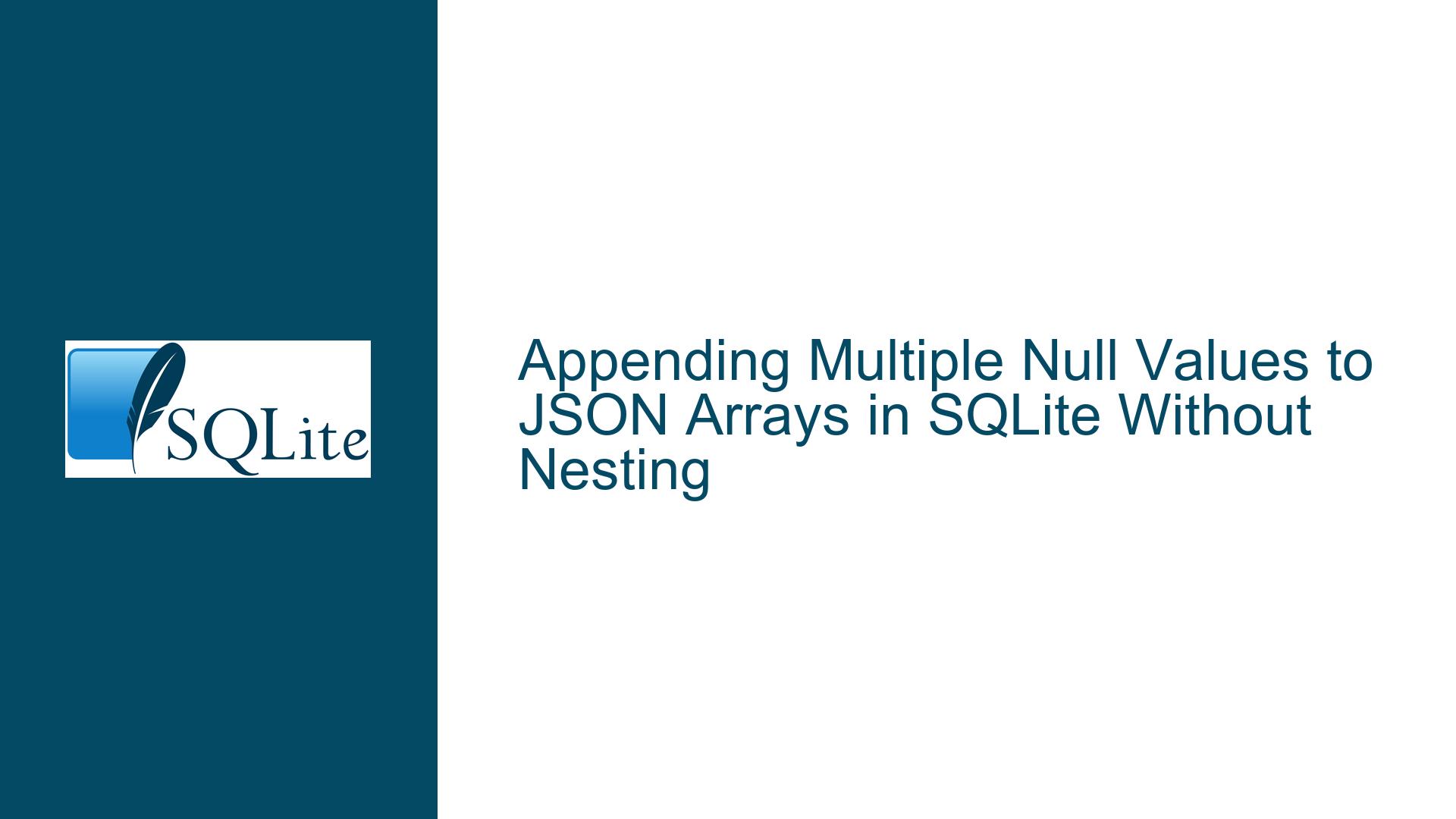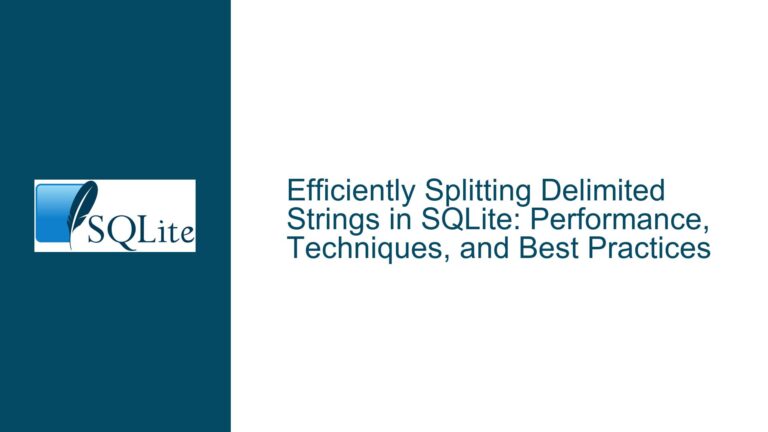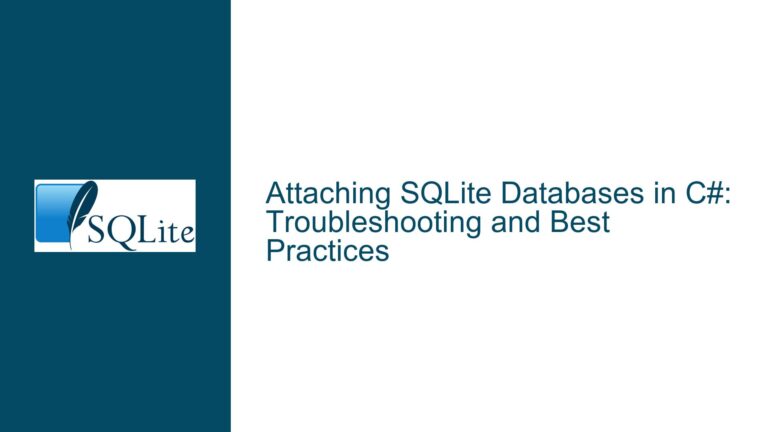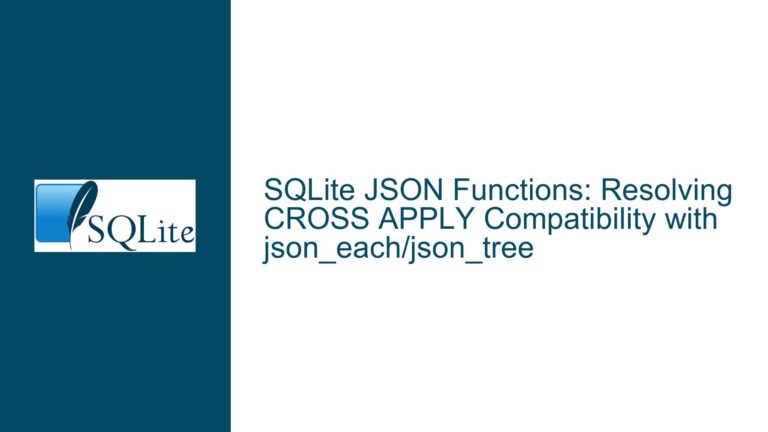Appending Multiple Null Values to JSON Arrays in SQLite Without Nesting
JSON Array Expansion Challenges in SQLite
When working with JSON data in SQLite, one common task is manipulating arrays within JSON objects. A frequent requirement is expanding the size of an array by appending multiple null values. This operation is particularly useful in scenarios where the array represents a fixed capacity that needs to be increased dynamically. However, SQLite’s JSON functions, such as json_insert, do not natively support appending multiple values to an array without nesting them. This limitation can lead to nested arrays, which are often undesirable and can complicate further data processing.
Consider a JSON object stored in an SQLite table where one of the elements is an array representing a capacity. For example:
{
"id": 3,
"items": {
"category": "foo",
"items": [
{"type": 1, "amount": 1},
null,
null,
null,
null
]
}
}
The goal is to increase the capacity of the items array from 5 to 10 by appending five null values. Using json_insert to append a single null value is straightforward, but appending multiple null values results in a nested array structure, which is not the intended outcome.
Limitations of Native JSON Functions in SQLite
SQLite provides a robust set of JSON functions, including json_insert, json_set, and json_array_length, which are essential for manipulating JSON data. However, these functions have limitations when it comes to array manipulation. Specifically, json_insert can only insert a single value at a time, and attempting to insert multiple values results in nested arrays. This behavior occurs because json_insert treats each insertion as a separate operation, leading to a hierarchical structure rather than a flat array.
For example, using json_insert to append multiple null values:
SELECT json_insert((SELECT items FROM example), '$[' || json_array_length(items) || ']', json("null")) FROM example;
This query appends a single null value correctly, but when attempting to append multiple null values, the result is a nested array:
[
null,
null,
null,
[
null,
null,
null
]
]
This nested structure is problematic because it deviates from the expected flat array format, making it difficult to work with the data in applications that expect a uniform array structure.
Combining JSON Functions for Array Concatenation
To achieve the desired flat array structure when appending multiple null values, a combination of SQLite’s JSON functions can be used. Specifically, the json_each table-valued function and the json_group_array aggregate function can be employed to concatenate arrays without nesting. The json_each function extracts elements from a JSON array, and json_group_array aggregates these elements into a new array.
Here is a step-by-step approach to achieve array concatenation:
- Extract Existing Array Elements: Use
json_eachto extract the elements of the existing array. - Extract New Elements: Use
json_eachto extract the elements of the new array containing the null values to be appended. - Combine Elements: Use a
UNION ALLoperation to combine the elements from both arrays. - Reconstruct the Array: Use
json_group_arrayto aggregate the combined elements into a new flat array. - Update the JSON Object: Use
json_setto update the original JSON object with the new array.
Here is an example SQL script that demonstrates this approach:
CREATE TABLE example(items JSON);
INSERT INTO example(items) VALUES('{"id":3,"items":{"category":"foo","items":[{"type":1,"amount":1},null,null,null,null]}}');
UPDATE example
SET items = json_set(items, '$.items.items',
(SELECT json_group_array(value)
FROM (SELECT value
FROM json_each(items, '$.items.items')
UNION ALL
SELECT value
FROM json_each('[null, null, null, null, null, null, null, null, null, null]')
LIMIT 10)));
SELECT * FROM example;
The result of this operation is a JSON object with the items array expanded to include the appended null values without nesting:
{
"id": 3,
"items": {
"category": "foo",
"items": [
{"type": 1, "amount": 1},
null,
null,
null,
null,
null,
null,
null,
null,
null
]
}
}
This method ensures that the array remains flat and avoids the pitfalls of nested arrays. By leveraging SQLite’s JSON functions in combination, it is possible to achieve complex JSON manipulations that are not directly supported by individual functions.
Practical Considerations and Best Practices
When working with JSON data in SQLite, especially when performing complex manipulations like array concatenation, it is important to consider the following best practices:
- Data Integrity: Ensure that the JSON data remains valid after manipulation. Use SQLite’s
json_validfunction to verify the integrity of the JSON data before and after updates. - Performance: Complex JSON manipulations can be resource-intensive, especially on large datasets. Consider the performance implications and optimize queries where possible. For example, limiting the number of elements processed in a single operation can help manage performance.
- Error Handling: Implement error handling to manage cases where JSON manipulations fail. This can include checking for null values, invalid JSON paths, and other potential issues.
- Testing: Thoroughly test JSON manipulations in a development environment before deploying them to production. This helps identify and resolve issues early in the development cycle.
By following these best practices, developers can ensure that their JSON manipulations in SQLite are both effective and efficient, leading to robust and maintainable database applications.
Conclusion
Appending multiple null values to a JSON array in SQLite without nesting requires a combination of JSON functions and careful query construction. While SQLite’s native JSON functions have limitations, creative use of json_each and json_group_array can achieve the desired results. By understanding the nuances of JSON manipulation in SQLite and following best practices, developers can effectively manage JSON data and ensure the integrity and performance of their database applications.






